Biophysics
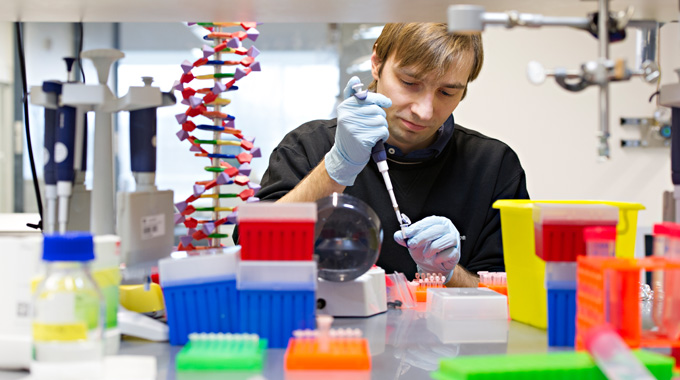 Dietz Lab. Photo: TUM/Eckert.
In biophysics, both the elementary molecular components of a cell and their interaction at the system level are investigated.
New experimental measurement methods and theoretical descriptions are developed and applied for this purpose. The aim of the research is to gain the most
comprehensive understanding of the fundamental mechanisms that ultimately make life possible or cause disease. These findings
ultimately contribute to the diagnosis and cure of diseases or form the basis for new biologically-inspired technologies such as
artificial photosynthesis or even self-organised manufacturing.
The complexity of living matter offers a fascinating opportunity to discover completely new physical laws far from chemical or thermodynamic equilibrium. The size of our
research area makes it possible to cover almost all aspects of this modern and highly interdisciplinary field of research.
Dietz Lab. Photo: TUM/Eckert.
In biophysics, both the elementary molecular components of a cell and their interaction at the system level are investigated.
New experimental measurement methods and theoretical descriptions are developed and applied for this purpose. The aim of the research is to gain the most
comprehensive understanding of the fundamental mechanisms that ultimately make life possible or cause disease. These findings
ultimately contribute to the diagnosis and cure of diseases or form the basis for new biologically-inspired technologies such as
artificial photosynthesis or even self-organised manufacturing.
The complexity of living matter offers a fascinating opportunity to discover completely new physical laws far from chemical or thermodynamic equilibrium. The size of our
research area makes it possible to cover almost all aspects of this modern and highly interdisciplinary field of research.
Spokesperson of the research area is Matthias Rief.
Molekulare Biophysik
Arbeitsgruppen:
Rief -
Simmel -
Dietz
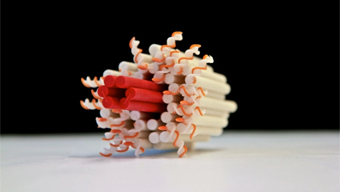 DNA nanotechnology can be used to build novel molecules, shown here is an artificial membrane channel. Photo: TUM.PH/Dietz Lab.
In the evolution of life, fascinating molecular machines have emerged, most of which are made up of proteins. These molecular
machines are significantly involved in all cellular processes. The spectrum of their biological function ranges from simple switches to molecular motors that
transport cargo along molecular rails to complex chemical synthesis units in which, for example, genetic information is replicated.
DNA nanotechnology can be used to build novel molecules, shown here is an artificial membrane channel. Photo: TUM.PH/Dietz Lab.
In the evolution of life, fascinating molecular machines have emerged, most of which are made up of proteins. These molecular
machines are significantly involved in all cellular processes. The spectrum of their biological function ranges from simple switches to molecular motors that
transport cargo along molecular rails to complex chemical synthesis units in which, for example, genetic information is replicated.
 Optical tweezers are used to determine the mechanics of individual molecules. Photo: TUM.PH/Dietz Lab.
Ultrasensitive measurement methods provide unique insights into the functioning of these fascinating molecular machines. That is why we are
working on the further development and application of mechanical and optical single-molecule methods, as well as high-resolution microscopy methods.
By combining biochemical and biophysical methods, it is also possible to produce novel nanodevices in order to manipulate single
molecules in a more targeted way or, for example, to artificially reproduce natural enzymes.
Optical tweezers are used to determine the mechanics of individual molecules. Photo: TUM.PH/Dietz Lab.
Ultrasensitive measurement methods provide unique insights into the functioning of these fascinating molecular machines. That is why we are
working on the further development and application of mechanical and optical single-molecule methods, as well as high-resolution microscopy methods.
By combining biochemical and biophysical methods, it is also possible to produce novel nanodevices in order to manipulate single
molecules in a more targeted way or, for example, to artificially reproduce natural enzymes.
Zelluläre Biophysik
Arbeitsgruppen:
Alim -
Bausch -
Simmel
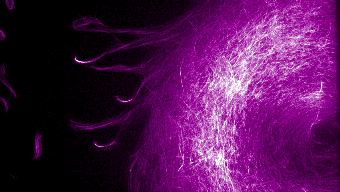 Pattern formation in a reconstructed cytoskeletal system. Photo: PH.TUM/Bausch Lab.
How can something as fascinating as life arise from individual molecules? All living organisms obey physical laws - even if the diversity and possibilities are qualitatively a completely different dimension compared to what we are used to from dead matter. How can we explain such complicated processes such as cell division or embryonic development?
While molecular biology or biochemistry focus on identifying the molecular causes, only physical concepts and methods can help us to understand the overarching principles. It is the task of biophysics to understand the multitude 30,000 identified proteins with all their interactions. The rapid developments of many physical
measurement and analysis methods (especially optical measurement techniques, optical imaging, micromechanics, microstructuring or microfluidics) is opening up
very exciting new possibilities to get to the bottom of what makes life possible.
Pattern formation in a reconstructed cytoskeletal system. Photo: PH.TUM/Bausch Lab.
How can something as fascinating as life arise from individual molecules? All living organisms obey physical laws - even if the diversity and possibilities are qualitatively a completely different dimension compared to what we are used to from dead matter. How can we explain such complicated processes such as cell division or embryonic development?
While molecular biology or biochemistry focus on identifying the molecular causes, only physical concepts and methods can help us to understand the overarching principles. It is the task of biophysics to understand the multitude 30,000 identified proteins with all their interactions. The rapid developments of many physical
measurement and analysis methods (especially optical measurement techniques, optical imaging, micromechanics, microstructuring or microfluidics) is opening up
very exciting new possibilities to get to the bottom of what makes life possible.
Theoretische Biophysik
Arbeitsgruppen:
Alim -
Gerland
-Zacharias -
Emeritus van Hemmen
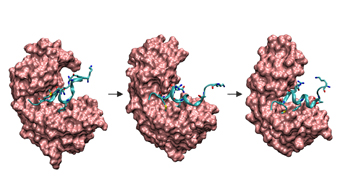 Simulation of the coupled folding and binding of a peptide to a protein.
In theoretical biophysics, we study biological systems and try to explain them with the help of theoretical concepts from physics. The
properties of biological systems are based on the complicated interplay and dynamics of a large number of molecular components. Molecular
simulation methods allow us to investigate the structure and dynamics of biological molecules. For example, biomolecules such as proteins,
take on defined spatial structures that determine their function. Such structure-forming or folding processes can be investigated by modern simulation methods at atomic resolution.
simulation methods at atomic resolution and with the inclusion of surrounding water molecules and ions. This allows an
analysis of the underlying structure-forming forces and thermodynamic and kinetic parameters. Many still unanswered questions about the
mechanism of specific structure formation can thus be elucidated by molecular simulations..
Simulation of the coupled folding and binding of a peptide to a protein.
In theoretical biophysics, we study biological systems and try to explain them with the help of theoretical concepts from physics. The
properties of biological systems are based on the complicated interplay and dynamics of a large number of molecular components. Molecular
simulation methods allow us to investigate the structure and dynamics of biological molecules. For example, biomolecules such as proteins,
take on defined spatial structures that determine their function. Such structure-forming or folding processes can be investigated by modern simulation methods at atomic resolution.
simulation methods at atomic resolution and with the inclusion of surrounding water molecules and ions. This allows an
analysis of the underlying structure-forming forces and thermodynamic and kinetic parameters. Many still unanswered questions about the
mechanism of specific structure formation can thus be elucidated by molecular simulations..
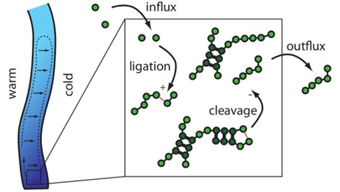 Model of a thermally driven reaction system.
Biological systems are highly dynamic not only at the molecular level but also in higher organisational units such as cell organelles or whole cells. Here, stochastic processes far from thermodynamic equilibrium often play an essential role. The interplay
of these processes determines and regulates cellular processes and leads to the self-organisation of cellular structures. For example, stochastic processes take place in cells that consume biochemical energy and thus generate a directed movement. With the help of mathematical methods and simulations on mesoscopic scales, models can be created to describe and explain such processes. In this context
the principles of organisation and regulation of stochastic processes in cells and their development in the course of evolution are still largely unknown and the subject of our research.
Model of a thermally driven reaction system.
Biological systems are highly dynamic not only at the molecular level but also in higher organisational units such as cell organelles or whole cells. Here, stochastic processes far from thermodynamic equilibrium often play an essential role. The interplay
of these processes determines and regulates cellular processes and leads to the self-organisation of cellular structures. For example, stochastic processes take place in cells that consume biochemical energy and thus generate a directed movement. With the help of mathematical methods and simulations on mesoscopic scales, models can be created to describe and explain such processes. In this context
the principles of organisation and regulation of stochastic processes in cells and their development in the course of evolution are still largely unknown and the subject of our research.
System-Biophysik
Arbeitsgruppen:
Bausch
- Simmel-
Emeritus van Hemmen
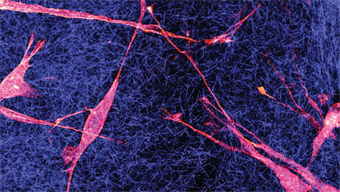 Epithelial cells interact with each other via the extracellular matrix. Photo: TUM.PH/Bausch Lab.
Biological systems are highly dynamic and many of their properties are based on the complicated interplay of a large number of molecular components or organisational units.
Our goal is to better understand and also control various aspects of these dynamics.
At the microscopic level, thermally driven, stochastic behaviour plays an essential role. There are also many processes that consume biochemical energy and thus generate, for example, directed motion. Biosystems are therefore far from thermodynamic equilibrium. Their complex structure often causes deviations from the standard behaviour of simpler systems, which leads to exciting new physical questions. For example, passive particles in the superdense cell interior perform a so-called "anomalous diffusion movement". This, in turn, contributes to the understanding of a variety of molecular
processes such as gene regulation, cellular defence mechanisms or cell division..
Epithelial cells interact with each other via the extracellular matrix. Photo: TUM.PH/Bausch Lab.
Biological systems are highly dynamic and many of their properties are based on the complicated interplay of a large number of molecular components or organisational units.
Our goal is to better understand and also control various aspects of these dynamics.
At the microscopic level, thermally driven, stochastic behaviour plays an essential role. There are also many processes that consume biochemical energy and thus generate, for example, directed motion. Biosystems are therefore far from thermodynamic equilibrium. Their complex structure often causes deviations from the standard behaviour of simpler systems, which leads to exciting new physical questions. For example, passive particles in the superdense cell interior perform a so-called "anomalous diffusion movement". This, in turn, contributes to the understanding of a variety of molecular
processes such as gene regulation, cellular defence mechanisms or cell division..
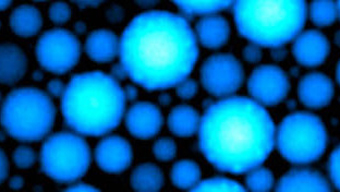 First steps towards minimal artificial cells: Fluorescence image of a transcription oscillator in a microemulsion.
Photo: TUM.PH/Simmel Lab.
At the level of neuronal cell assemblies, we are interested in sensory information processing. Based on various inputs from auditory and visual organs,
the lateral line system of fish and frogs or the infrared pit organ of snakes, a unified representation of the sensory environment is formed in the brain, which enables decision-making. The dynamics of these processes in particular are the focus of our research interest..
First steps towards minimal artificial cells: Fluorescence image of a transcription oscillator in a microemulsion.
Photo: TUM.PH/Simmel Lab.
At the level of neuronal cell assemblies, we are interested in sensory information processing. Based on various inputs from auditory and visual organs,
the lateral line system of fish and frogs or the infrared pit organ of snakes, a unified representation of the sensory environment is formed in the brain, which enables decision-making. The dynamics of these processes in particular are the focus of our research interest..
One of the main aspects of the work area Dynamics of Biosystems is to investigate the dynamic processes described above experimentally and theoretically by "reproducing" them in synthetic biological systems in a controlled manner or analysing them with the help of mathematical models. In doing so the self-organisation of biomolecular and cellular structures, the optimisation of the underlying active and passive search processes, as well as the passive search processes, as well as the resulting information processing in biochemical and neuronal networks.
Biomedizinische Physik
Arbeitsgruppen:
Hugel -
Pfeiffer
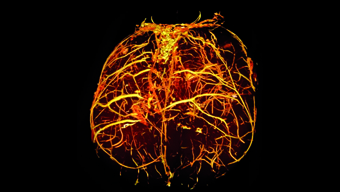 Biomedical imaging techniques. Photo:TUM.PH/Pfeiffer Lab.
Biomedical physics explores the application of principles and methods of fundamental physics to medical problems in preclinical or clinical research. Research focuses in particular on new imaging methods for improved early detection and diagnosis of diseases, such as cancer and osteoporosis, as well as their cure through the use of novel physical principles. A further goal is a molecular understanding of diseases, especially those caused by amyloids (such as Parkinson's or Alzheimer's disease). The research, development, and clinical implementation of novel X-ray, magnetic resonance, or positron emission imaging methods is carried out in close with the Central Institute for Medical Technology (IMETUM) and physicians at the Klinikum rechts der Isar.
Biomedical imaging techniques. Photo:TUM.PH/Pfeiffer Lab.
Biomedical physics explores the application of principles and methods of fundamental physics to medical problems in preclinical or clinical research. Research focuses in particular on new imaging methods for improved early detection and diagnosis of diseases, such as cancer and osteoporosis, as well as their cure through the use of novel physical principles. A further goal is a molecular understanding of diseases, especially those caused by amyloids (such as Parkinson's or Alzheimer's disease). The research, development, and clinical implementation of novel X-ray, magnetic resonance, or positron emission imaging methods is carried out in close with the Central Institute for Medical Technology (IMETUM) and physicians at the Klinikum rechts der Isar.